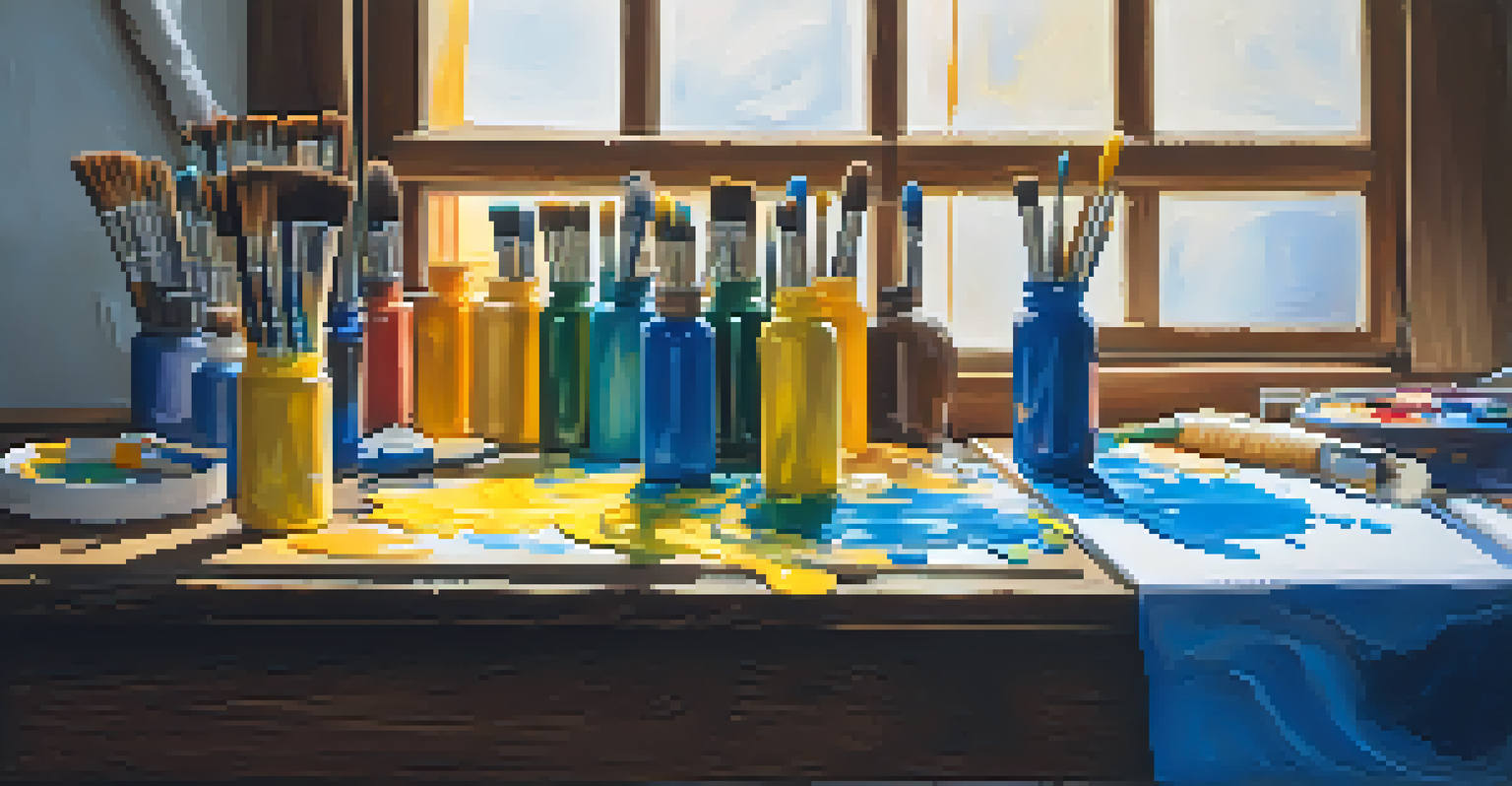Exploring Symbolism in Art: Adding Deeper Meanings to Works

Understanding Symbolism: What Does It Mean in Art?
Symbolism in art refers to the use of symbols to convey deeper meanings beyond the surface. Each element, whether it's color, object, or figure, can represent complex ideas and emotions, allowing artists to communicate their thoughts in a subtle way. For instance, a dove might symbolize peace, while a skull can represent mortality, inviting viewers to think critically about the themes presented.
Art is the most beautiful of all lies; it is a symbol, a metaphor, a reflection of the soul.
When we look at a piece of art, it's essential to consider not just what we see but also what we feel and think about it. This adds a layer of depth that can transform a simple image into a profound statement. An artist might choose a specific symbol to evoke a particular feeling, making us reflect on our own experiences and beliefs.
Ultimately, understanding symbolism helps us appreciate the artist's intent and the context of their work. It opens up a dialogue between the artwork, the artist, and the viewer, enriching our experience and inviting us to explore our interpretations.
Historical Context: How Symbolism Evolved Over Time
Symbolism in art has a rich history that dates back to ancient civilizations, where symbols were pivotal in conveying cultural and spiritual beliefs. For example, the use of hieroglyphics in Egyptian art served as both decoration and a means of communication, embedding deeper meanings into their visual narratives. As art movements evolved, so did the approach to symbolism, reflecting changes in society and thought.

During the Renaissance, artists began to infuse their works with Christian symbolism, using imagery to convey their religious beliefs and moral lessons. Think of how Leonardo da Vinci's 'The Last Supper' uses various elements to symbolize loyalty and betrayal, enriching the story beyond the literal interpretation. Each brushstroke was intentional, guiding viewers to uncover these layers.
As we moved into the 19th and 20th centuries, artists like Van Gogh and Picasso embraced symbolism to express their inner thoughts and emotions, often reflecting personal and societal struggles. This evolution illustrates how symbolism not only represents specific ideas but also adapts to the changing landscape of human experience.
Common Symbols in Art: Their Meanings and Interpretations
Certain symbols have become ubiquitous in art, each carrying its own rich tapestry of meanings. For instance, the color red is often associated with passion and love, while blue can evoke feelings of calmness or sadness. Artists strategically choose these colors to reinforce the emotional undertones of their work, making the symbolism overt and accessible.
The painter tries to master the art of expression, and the artist is a master of symbols.
Animals often play a significant role in symbolism as well. A lion might symbolize courage and strength, while a butterfly can represent transformation and the fleeting nature of life. When we see these symbols, they invite us to think about their broader significance and how they relate to our own lives.
Understanding these common symbols can enhance our appreciation of art, allowing us to connect on a deeper level. It encourages us to question the artist's choices and the messages they wish to convey, making the experience of viewing art much more personal and engaging.
The Role of Colors in Symbolism: More Than Just Aesthetic
Colors are powerful tools in art, serving as symbols that can evoke a wide range of emotions and ideas. For example, green often symbolizes nature and renewal, while black can represent mourning or elegance. Artists use color intentionally to elicit feelings in the viewer, enhancing the overall impact of their work.
Consider how Van Gogh’s use of vibrant yellows in 'Sunflowers' captures warmth and cheerfulness, inviting the viewer to experience joy. Conversely, the muted tones in Edvard Munch's 'The Scream' intensify feelings of anxiety and despair. This illustrates how colors are not merely decorative; they carry deep meanings that contribute to the narrative of the artwork.
By paying attention to color symbolism, we gain insights into the emotional landscape the artist is navigating. It allows us to decode the visual language of art, enriching our understanding and appreciation of each piece.
Interpreting Symbolism: Subjectivity and Personal Experience
One of the most fascinating aspects of symbolism in art is its inherent subjectivity. Each viewer brings their own experiences, beliefs, and emotions to the artwork, leading to diverse interpretations of the same symbol. This personal lens allows us to connect with art on a unique level, making the experience truly individual.
For instance, a viewer might see a broken chain in a painting and interpret it as freedom from oppression, while another might see it as loss or abandonment. Both interpretations are valid and showcase how symbols can resonate differently with different people. This dialogue between the artwork and the viewer enriches our engagement with art.
Embracing this subjectivity encourages us to explore our feelings and thoughts about what we see. It empowers us to share our interpretations, fostering discussions that can lead to deeper understanding and appreciation of the artwork and the artist's intent.
The Impact of Cultural Background on Symbolism in Art
Cultural background plays a significant role in shaping how symbolism is understood and interpreted in art. Symbols can carry different meanings across cultures, influenced by historical, social, and religious contexts. For example, the lotus flower in Eastern cultures symbolizes purity and enlightenment, while in some Western contexts, it may not hold the same significance.
This cultural lens is crucial when examining works from diverse backgrounds. An artist’s use of symbols may reflect their cultural heritage, inviting viewers to consider their meanings within that specific context. Engaging with this aspect can deepen our understanding of the artwork and broaden our perspectives.
By exploring cultural symbolism, we not only appreciate the art itself but also gain insights into the values and beliefs of different societies. It fosters a sense of respect and curiosity about the diverse expressions of human experience found in art from around the world.
Conclusion: The Lasting Power of Symbolism in Art
Symbolism in art remains a powerful tool for expression, allowing artists to convey complex ideas and emotions. It enriches our understanding of artworks, inviting us to look beyond the surface and explore deeper meanings. As we engage with art, we uncover layers of significance that resonate with our own experiences and beliefs.
The beauty of symbolism lies in its ability to connect people across time and cultures. It creates a shared language that transcends literal interpretation, enabling us to communicate our feelings and thoughts in ways that words sometimes cannot express. This connection fosters a sense of community among art lovers and encourages dialogue.

Ultimately, exploring symbolism in art enhances our appreciation and understanding, making each viewing a journey of discovery. As we delve into the meanings behind the symbols, we engage more profoundly with the artwork, the artist, and ourselves.